Back in time
Four of us hanging out in Aztec, New Mexico, after a long driving day: We chose an older refurbished three-bedroom house turned bed & breakfast. With unpacking complete, cupboards & closets explored, wine poured, the interest centered around a documentary about the next day’s destination - mysterious Chaco Canyon . . .
but first . . .
. . . although our first day out consisted primarily of road travel, a few welcome stops gave us relief from the countryside zooming past the truck windows, however unusual, beautiful, unique or fascinating it may be.
Our initial halt was at the Cameron Trading Post. Granted, we have been there a multitude of times over the years; however, our traveling companions, Tom & Pam, had discovered a charming facet of the establishment that had escaped our notice, and they were anxious to share it.
Secreted within the confines of Cameron’s lodging facility is one of the more charming garden areas I have encountered. Sheltered under the interlaced tree boughs, varying levels of walkways offered access to expansive garden beds, planned, planted and carefully tended.
As we made our way from one section to another, marveling and remarking at the tranquil beauty, suddenly materialized before us a gardener of extraordinary presence, a Navajo man by the name of Leon. As he basked in our exuberance about his gardens, he shared his story and invited us to reciprocate. Indeed, Leon was so intriguing that our allotted time was consumed in conversation about Leon's desire to share the wonders of nature and of gardens, personal & family values, the importance of water in the desert, the variety of birds and birders in that oasis, and so much else that my photography consisted only of a few quick snapshots, but what a worthwhile stop - one that shall be repeated when ample time allows a proper appraisal of that inviting sanctuary.
Road trippin' . . .
. . . can be, and often is a direct route from starting point to arrive at a destination, but really what fun is that when there are always things to see along the way. To that end, we departed the Cameron gardens and Leon to our next stop at Navajo National Monument.
Goofing around in the visitor's center was irresistible . . .
. . . with that out of our systems, we embarked on a walk to a lower elevation where we could see the prehistoric cliff dwelling known as Betatakin. Access to the site itself is available only with an organized guided tour, so our view of it in its massive protected alcove was from a distance across the canyon.
The canyon is a beautiful sight in its own right with its massive cliff walls rising vertically above the wide bottom.
Along the way, we saw a large dinosaur track; luckily, the creature that made the imprint had departed the region some time back.
Another fine find . . .
As our day stretched out and our picnic lunch faded into the mists of time (okay, that's a bit over the top, but we were getting hungry), we resorted to smart phone wars to see who could locate an appropriate dinner eatery that remained open until our anticipated arrival time, and to garner a majority of votes. "No" to New Mexico-hot, "no" to fast food, "no" to chain establishments: the votes were clear.
As we eliminated one after another, or they eliminated themselves with absurdly early closings, it was unanimous for Three Rivers Brewery, and we were enchanted with it. Located in a handsome 1912 edifice that was a pharmacy once in its lifetime, the interior was fascinating with artifacts from the hundred-some years of its existence.
Four separate entrees sated four separate travelers very well indeed with a variety of unusual selections. I wished for the place to be in Prescott so that I could frequent it often, but alas, there are not three rivers in our vicinity, and wishes are not fishes.
And then the mystery that is Chaco . . .
At some point around 850 CE, the Chacoan people began constructing their magnificent cities of stone, expanding outward from where we visited in Chaco Canyon with so-called outliers disbursed through much of the Four Corners Region.
The Chaco Culture National Historical Park is not the easiest site to reach: it requires a 30-mile(ish) drive from the highway, about half of it on washboardy dirt road, but what a worthwhile endeavor it is. Those willing to make the drive are rewarded along the way with scenery many experience only in photographs. The experience takes the traveler into a landscape of mammoth mesas rising from plains cut deeply & jaggedly by storm-swollen rivers, more often reduced to wide sand-filled washes.
It is a landscape marvelous in its majesty, fitting that the Chacoans built their cities in its midst.
A film at the visitors center made a good introduction to what followed as we filled our day walking through the many ruins that punctuate the canyon. Many of them have been excavated to the extent that it's possible to wander right into and through the rooms where those people lived until about 1250 CE.
Seemingly impossible in what we consider primitive times, the Chacoans planned the huge canyon structure complex prior to construction, and oriented their buildings according to solar, lunar and cardinal directions.
They include sophisticated astronomical markers, communication features and water control devices.
According to published literature: "By 1050, Chaco had become the ceremonial, administrative, and
economic center of the San Juan Basin. Its sphere of influence was
extensive. Dozens of great houses in Chaco Canyon were connected by
roads to more than 150 great houses throughout the region. It is thought
that the great houses were not traditional farming villages occupied by
large populations. They may instead have been impressive examples of 'public architecture' that were used periodically during times of
ceremony, commerce, and trading when temporary populations came to the
canyon for these events."
That is by no means the only interpretation of the Chacoan culture; opinions vary and much has been written regarding the enigma of how and why those ancients built the way they did. In the end, though, there is no doubt that Chaco Canyon is considered sacred and ancestral to current Puebloan peoples of the Southwest.
Alert: If you are of the persuasion that "If you've seen one, you've seen 'em all", you might want to skip past this next section. I have included the signage for each of the Great Houses we visited. I was struck by the huge number of clan kivas that were within the ruins, and awed by the Great Kivas that included rectangular structures used as foot drums, and stone benches around the circumference.
Chetro Ketl . . .
The Chacoan construction was clearly of great strength, with three-story complexes standing after so long a time. At the same time, it seems to have been done with great precision and artistry. Some of the photos show the horizontal lines of squared-off sandstone blocks with millions of smaller rocks meticulously placed in alternating rows.
Although Chacoan people were not as tall as modern folks, even they had to duck to go through doorways made shorter, possibly for strength of construction, enhanced heat retention or defensive reasons.
Lines of round holes in the walls allowed for the insertion of wood beams to support floors of second- and third-stories.
There were some unusual corner doors and windows.
Huge amounts of wood for ceilings/floors and lintels was brought from distant timbered mountain ranges.
Hungo Pavi . . .
Many of the Great Houses were in an extensive planned complex at the foot of an imposing rock cliff. It undoubtedly would have radiated welcome heat on winter days, a warmth that was not as appreciated when our day extended into late afternoon.
Remnants of original wood beams are visible throughout the complex.
Pueblo Bonito . . .
. . . the grande dame of Chaco Canyon.
In the 1920 & 1930s, the National Geographic Society and the Smithsonian Institution removed 100,000 pounds of rubble and wind-blown sand to reveal Pueblo Bonito, and rebuilt some walls to match the ancient masonry. Most wall remnants have been stabilized along the tops to slow deterioration.
The following photo was taken from the film crew's vantage point looking down at the remains of Pueblo Bonito.
Pueblo Del Arroyo . . .
Casa Rinconada . . .
Ancient writings, reptiles . . .
Not surprisingly, petroglyphs were present along the cliff face.
I wondered if this one depicted a mountain lion.
My interpretation of this one, for what it's worth, shows the horror of an adult seeing a child falling.
This is surely significant, but of what I can't imagine.
This bird was my favorite.
Does this depict a solar eclipse or could it be a representation of a supernova in the Crab Nebula, an event in 1054 so bright that it was visible during daylight, as recorded in historical accounts?
A very clear representation of the Kokopelli, the humpbacked flute player - a fertility deity.
With chameleon-like qualities, every lizard we saw blended perfectly with its surroundings.
Pueblo Pintado . . .
An outlier at some distance, the señor & I had also previously been to Pueblo Pintado, and were anxious to show it to our friends. All well & good; however, in the intervening 40-some years, we had forgotten how to get there.
Once again, out came the GPS devices which may have gotten us into the vicinity, but there we were, and it wasn't. Evidently, our search had taken us to the "town" of Pueblo Pintado, with nary a sign nor a ruin anywhere that we could spy.
Other dirt roads had led us to that juncture: we were out in an enormous expanse of the Navajo Reservation, with an occasional small unassuming abode away at the end of a long driveway with the entrance usually marked by a couple of discarded car tires hanging on posts.
As it turned out, we finally found ourselves "downtown", consisting of one lone market that might or might not have been open, by the looks of it. Fortune smiled on our quest: the store was indeed open, and a person inside gave us the kind of vague directions that typically end with "You can't miss it".
Fortified by exorbitantly-priced ice cream bars, we continued the search by wandering up & down every small dirt track in our vicinity. As daylight waned, we discussed the merits of throwing in the proverbial towel until at last, that which we sought was found.
The only memory I had of it was that it was incredibly captivating; I instantly was overcome again with the energy of the place. The other places we'd seen were fascinating, but for me, this was even more special.
Pueblo Pintado (Painted House) dominates the surrounding landscape from its commanding hill-top site. If as it is believed, the exterior was white-washed, the massive three-story structure would have indeed been a sight to demand attention.
It has less a southwestern aura and inexplcably more a European feel to me. It was lovely that we had the place entirely to ourselves.
Only a portion of Pueblo Pintado has been excavated. The hillsides below and around the imposing uppermost edifice reveal bits of rock walls among the grassy hummocks that belie the ruins beneath.
There is little besides many miles of open landscape to be seen from the site of Pueblo Pintado.
We sheepishly call a halt . . .
Many times, we have encountered great herds of sheep being moved with the seasons from high country to lower elevations, and back again, but never before have we been stopped along with city traffic for such a movement as we were in Bayfield, Colorado. All traffic was halted as a river of sheep flowed across a busy intersection. I jumped out of the car to snap a few shots of the unusual stoppage.
Chimney Rock . . .
. . . in North Carolina is getting lots of publicity after being severely damaged by Hurricane Helene, but the Chimney Rock we traveled to is in southern Colorado, and is another Chacoan outlier, one that defies the imagination about its construction high atop a narrow ridge.
We climbed up and along the ridgetop, accompanied by a knowledgable guide. We were even provided with walking sticks, something I don't typically utilize, but which I found very helpful on the rocky surface.
The expansive views were incredible, and made it easy to understand how signaling could be effected from that vantage to a series of line-of-sight places.
Chimney Rock is considered a sacred place for many, and is unique in its structures that align with prehistoric and historic astronomical events.
Chimney rock and Companion Rock as viewed from the ridgetop structures.
I'm not sure how high we were above the surrounding countryside, but it was a far piece.
We made it to the top . . .
. . . and here's the proof.
All that labor caused us to work up an appetitite . . . and well, we were not far from Pagosa Springs, so it was unanimous to head that way for lunch at Kip's, our favorite eatery up that direction.
A bit of dawdling later, we turned back toward New Mexico and the Chacoan ruins at Aztec.
Aztec Ruins, Old Spanish Trail, the Animas . . .
Our time there was shortened by our arrival near the time of the National Monument's closing hour; it made for a bit of a rushed walk-through the very interesting and well-preserved site.
In addition to the Chacoan site right in the midst of the town of Aztec, the place is known for a historic crossing of the Animas River. In 1829, a Spanish caravan of about 60 men and 100 mules forded the river there on what came to be called the Old Spanish Trail.
The group was pioneering a route between Santa Fe, New Mexico, and Los Angeles, California, Mexican territory at that time.
An early morning departure next day sped us on our way toward home after a very eventful and enjoyable journey. After stopping for a picnic lunch, we arrived in Prescott just in time to unpack and get ready for the señor's evening music gig.
















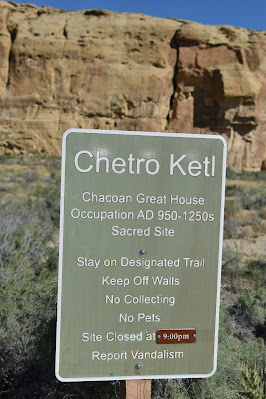


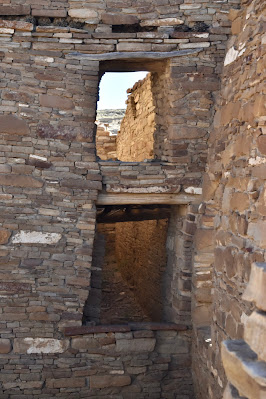

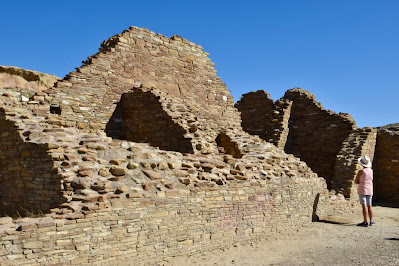









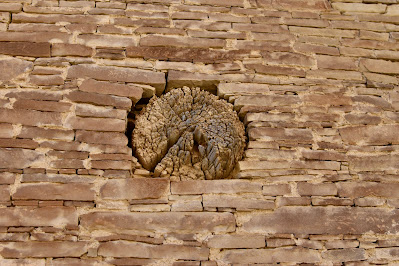






















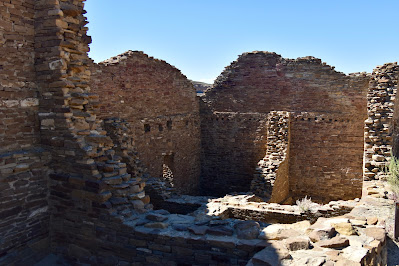











 r
r












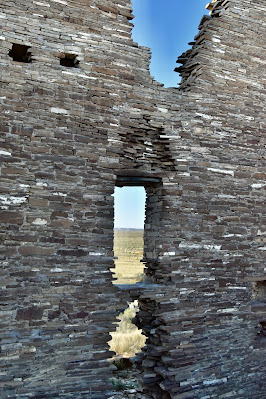
















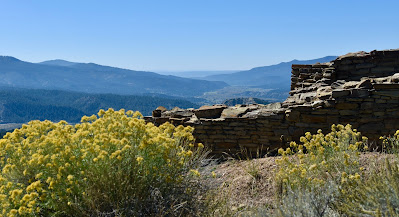











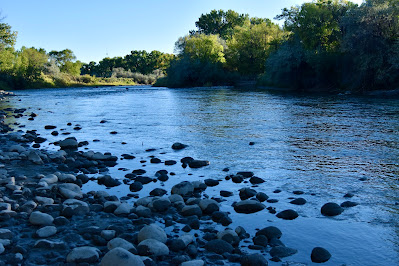

No comments:
Post a Comment